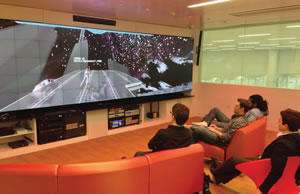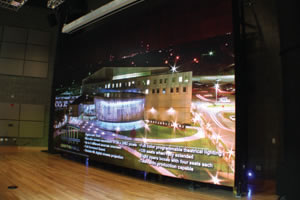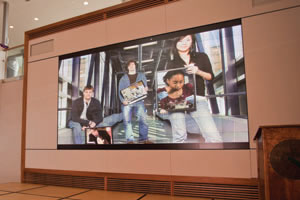Big Screen on Campus

PHOTOS COURTESY OF CHRISTIE DIGITAL SYSTEMS
Video displays are taking over the world.
Okay, that may be overstating things a bit. But displays do seem to be proliferating. That’s certainly the case for campus settings, where creative uses of video walls, digital signage, projectors and other display technologies are fostering new ways to communicate.
“Just like every other public environment where people congregate and interact — from shopping malls to airports to museums — the use of digital displays has exploded on campuses,” says Steve Seminario, senior director of product marketing for Planar Systems. He points out that for most institutions, an additional factor is that the primary constituents, 20-something students, are among the most digitally literate demographic in society. At the same time, responses to parents’ expectations that students will be safe and productive on campus include increasing use of digital solutions, including displays.
“From announcements to wayfinding to emergency notification to collaboration to presentation to scientific visualization to entertainment, we’ve seen our displays and video walls being used for all those campus applications and more,” Seminario says. “It’s a trend we have not seen slowing down.”
In fact, the most attractive aspect of these developments may be the potential they offer to support different areas of operations, from the classroom to the general campus environment.
“We think about digital delivery from the perspectives of both digital signage and classroom technology,” says Scott Cann, technology director, ITS support services at Boston College. “Demand in both areas is always growing steadily, largely because we see how this can add value to the experience.”
An example is the University of Michigan’s Crisler Center, where athletic events are enhanced through the use of an array of interactive displays. In the concourse, they include a series of 46-inch displays from Planar. Fans can use them to check out stats from recent games, view photos or text on any of the university’s sports or purchase tickets. Displays are also used to create interactive programs for kids and offer historic overviews from the basketball program’s past. With touch-screen technology, LED backlighting and other features, the displays also have an ultra-slim profile that supports easy integration into their surroundings.
At North Carolina State University, four large video walls have been built into the public spaces around the Hunt Library. Built with “MicroTiles” from Christie, the displays focus on demonstrating the university’s impact in a number of areas. A recent display highlighted the work of more than 25 faculty members in international activities.
Similarly, Florida Atlantic University’s College of Business uses a video wall to share stories and successes of students and faculty. And Iowa State University has installed a 12-screen video display to highlight work undertaken in the department of electrical and computer engineering. Measuring 16 feet wide by seven feet high, the wall can display single or multiple video streams.
On Miami Dade College’s Kendall Campus, a newly opened academic support center has each classroom equipped with a projector from Epson’s PowerLite Pro Z series. Along with classroom applications, the projectors are also used for presentations in conference rooms and auditoriums.
Cann notes that classroom technology has its obvious benefits to teaching and learning, where the demands are often dictated by pedagogical and technology trends.
“With classroom technology, the key is balancing innovation with reliability and repeatability,” Cann says. “Striking this balance is critical.” At his university, technology specialists work hand-in-hand with instructional designers and e-teaching specialists to integrate new technology in the classroom, while maintaining a reliable system for faculty and students.
Reading the Signs
With digital signage, the major challenge is content, Cann says.
“The value of any of these systems is only as good as its content management approach,” he says. “Identifying who will generate and manage the content lifecycle is key.”
Digital signage was once viewed as just an extension of video, but now it has become much more, according to Shari Sentlowitz, market development manager, education solutions for Sony Electronics Professional Solutions of America. “Schools are developing their own content specifically for these screens with video, graphics, and piping in their feeds from social media sources.”
The most prominent trends from a technical viewpoint, she notes, are touch-screen interactivity and integrated audio.
“Interactivity is going to become even more prevalent in schools, especially in high-traffic campus areas where the need exists to connect, direct and engage with students,” Sentlowitz says.
Along with their primary value in supporting instruction and fostering communication, another benefit of digital displays is relevancy.
“Unlike posters, messages across digital signage networks are easier to remain current and relevant,” Sentlowitz notes. “They can be changed on the fly if and when needed.”
She adds that since students are used to getting their information from the smaller screens of computers, tablets and phones, they readily adapt to the use of larger displays. Too, since digital signage can deliver multiple messages with relevant content, it can be useful for communicating with a diverse audience of students, faculty, staff and visitors.



PHOTO © BRIAN MELTZ, EMORY PHOTO/VIDEO
IS THERE ANYTHING GOOD ON? Video displays are being integrated into all areas of campus and offering a broad range of uses, from announcements of campus or current events, wayfinding, emergency notifications, entertainment, content delivery, scientific visualization and more. Interacting with and learning from display screens is a natural for digitally literate 20-somethings.
The Right Choices
Seminario notes that since display technology is dynamic and continually evolving, choosing the right display can be a challenge.
“One thing you hate to see is when the wrong display technology was selected for a particular application,” he says. “A simple example would be using a display technology that looks great in controlled lighting environment like a classroom, but is completely washed out when deployed in a student union with floor-to-ceiling windows.”
A strategy for avoiding such problems is seeking knowledgeable advice before making selections.
“Working with an experienced AV consultant or integrator can really save downstream issues,” Seminario says.
Michael Courtney, a design expert based in Seattle, encourages a global approach.
“Treat this as a design project, not a hardware purchase,” he says. “If your project involves more than placing a flat screen on a wall, it’s important to plan the integration into an information system, wayfinding program, architecture, landscape or urban design.”
Courtney recommends bringing a design team into the project as early as possible.
“Engaging a design firm for pre-design or scoping phase will help identify the overall scope of the project, clarify wants and needs, get the stakeholders on the same page and establish a realistic schedule and budget,” he says.
A comprehensive budget should include more than just the costs for basic equipment, Courtney adds. Other needs may include software, programming, back-end equipment, mounting equipment and the IT infrastructure to support and maintain the system.
Seminario adds that looking for case studies and installation profiles on the web can also prove helpful.
“If you can see how a university implemented an interactive touch wall in their athletic department or another implemented a video wall in a student union or a welcome center, it can provide an excellent way to visualize what’s really possible with digital display technology.”
Helpful Tips
Sony Electronics’ Shari Sentlowitz offers these tips for dealing with display technology:
- When planning and buying a system, make sure that you have a budget for ongoing maintenance, support and upgrades.
- Before deciding on a solution, get involvement from the stakeholders early on to determine requirements and resources. In order to be successful the signage has to work for the stakeholders.
- Too many cooks in the kitchen is not a good thing when it comes to digital signage. Identify one technology leader from your IT department who can lead the team and concentrate on the deployment of the hardware. Also, select a content leader to coordinate guidelines for content and help stakeholders manage their content.
This article originally appeared in the issue of .